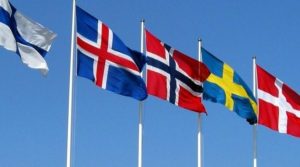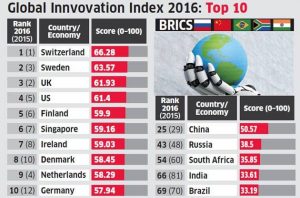Why Nordic countries top the innovation indexes?
The Nordic countries comprise of a geographical and cultural region in Northern Europe and the North Atlantic, where they are most commonly known as Norden which literally means ‘The North’. It includes Denmark, Finland, Iceland, Norway, and Sweden including their associated territories Greenland, Faroe Island and Aland Island. The population of the Nordic countries belongs mainly to Scandinavian or Finnish communities. And their main religion is Lutheran Christianity.
The Bloomberg Innovation Index which uses parameters such as research and development spending, value-added manufacturing, productivity and the concentration of high-tech public organizations scores. In its 2017 innovation index has announced Sweden at number two and Finland at number five in the top five! Bloomberg Indiex is called ‘The battle of ideas’.
Every year, the World Economic Forum releases its Global Competitiveness Report on the state of the world’s economies based again on innovations and productivity, which takes into account things like the quality of scientific research at universities, company spending on R&D (research and development), collaboration between universities and industry, patents, and the number of engineers and scientists in each country.
The 2016 ranking by WEF puts Sweden in the top 10 countries for the ease of doing business. The WEF looks at data on areas as varied as the soundness of banks to the sophistication of businesses in each country. It then uses the data to compile a picture of the economy of almost every country on earth. In WEF’s index also Denmark is lauded for its leadership in world for renewable energy technology, with 140% of the country’s energy being met by wind power.
Finland is “well positioned in terms of innovation,” WEF says, with its capacity to innovate supported by the excellent availability of scientists and engineers and a high degree of collaboration between universities and industry. The government funds high amount on R&D as well as corporate innovation projects.
WEF recognizes Sweden for its several high-profile technical success stories over the past decade; WEF thinks that Sweden is well equipped to embrace the Fourth Industrial Revolution, with a strong score on technological readiness and ranked within the top 10 in innovation. However, the availability of scientists and engineers is falling. It is a reminder to the country that renewed efforts are required to invest in human capital and skills to ensure long-term competitiveness and innovation capacity, for which Nordic countries are known.
Since 2008, Cornell University, INSEAD, and the World Intellectual Property Organization release the annual Global Innovation Index (GII). Basically, it’s a list of the most innovative countries in the world. In its 2016 GII index Sweden, Denmark, Iceland and Finland have scored high numbers.
The GII index also recognizes Sweden for its improvements in the basic factors of competitiveness, especially the macroeconomic environment. Sweden’s labor market functions reasonably well and the country is reported to have a high employment rate, with a high level of women’s participation in the workforce. Though WEF index suggests that Sweden has dropped its performance in terms of the effect of taxation on incentives to work, and restrictive labor regulations are perceived as the second-most problematic factor for doing business. In addition, the availability of scientists and engineers is falling, which is a reminder that renewed efforts to invest in human capital and skills are necessary to ensure long-term competitiveness and innovation capacity. What we need to note is that Swedes themselves promote an atmosphere of great personal ambition.
The Nordic countries share a common economic perspective. They are all small, open economies in which foreign trade has great economic significance. These countries have evolved rapidly from poor, agrarian countries into modern industrialized economies among the most competitive countries in the world. The “Nordic model” is therefore considered attractive by other countries in world by both individuals and policy-makers. The model is based transparency, pragmatism and the nationalist spirit among the citizens. These smaller countries are proud owners of large public sectors, including welfare services, and high taxation. And, they have performed so well economically.
Though there are some notes of cautions for these countries such as: small, open economies are particularly vulnerable to international economic fluctuations. For example, in the financial crisis of 2008, Iceland was hit hard. Though, Finland and Sweden endured severe economic crises in the early 1990s, and Norway experienced a banking crisis around the same time. In the 1980s, Denmark suffered a serious structural crisis that led to the implementation of a comprehensive emergency program famously known as “potato diet”. The crises of the 1990s also led to many structural changes in the Swedish and Finnish economies, and Iceland is now going through the throbbing process of transformation.
But it is really appreciable these small Nordic countries are dominating the innovation indexes in research, infrastructure, institutions, market and business sophistication, and a commitment to knowledge and creativity!! The Nordic countries pride themselves on the honesty and transparency of their governments. A point to note here is that Nordic governments are subject to rigorous inquiry: for example, in Sweden everyone has access to all official records. Politicians are disparaged if they get off their bicycles and into official limousines. Transparency tops the governance of these small yet dynamic countries.
The Nordics have added two other important qualities to transparency: pragmatism and determinedness. When these countries realized that the old social democratic consensus was no longer working, they let it go with remarkably little fuss and introduced new ideas from across the political spectrum. They were absolutely determined in pushing through reforms. It is stupidity to mistake Nordic geniality as their vulnerability. Pragmatism explains why the new consensus has quickly replaced the old one. Nordic countries can often seem to be amalgams of left- and right-wing policies.
They still have plenty of problems: their governments remain too big and their private sectors too small. Their taxes are still too high and some of their benefits too generous. The Danish system of flexicurity (flexi security) puts too much emphasis on security and not enough on flexibility. Norway’s oil boom is threatening to destroy the work ethic. It is a bad sign that over 6% of the workforce are on sick leave at any one time and around 9% of the working-age population live on disability pensions. But the Nordics are continuing to introduce structural reforms, thought bit slowly, they are continually working on them. The lesson the world should take from them is their ability to invest in human capital and protect them first.
















































